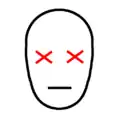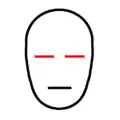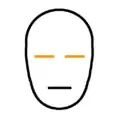Disability judo classification is the medical classification system for disability judo. Judokas with a disability are classified into different categories based on their disability type. The classification is handled by the Blind Sports Association.
Definition
The blind classifications are based on medical classification, no functional classification.[1]
 Visualisation of functional vision for a B1 competitor
Visualisation of functional vision for a B1 competitor Visualisation of functional vision for a B2 competitor
Visualisation of functional vision for a B2 competitor Visualisation of functional vision for a B3 competitor
Visualisation of functional vision for a B3 competitor
Beyond the level of vision impairment, research done at the Central Institute on Employment Abilities of the Handicapped in Moscow has found differences in functional capabilities based on differences in visual acuity. This does not play a significant role in judo.[2]
Governance
The sport's classification system is governed by the International Blind Sports Association.[3][4]
Eligibility
As of 2012, people with visual disabilities are eligible to compete in this sport.[3][5] The sport is also open to blind people with hearing loss.[3]
History
In 1992, the International Paralympic Committee formally took control of governance for disability sport.[6]
Classes
Classes for the sport are based on weight, not based on functional disability.[3] B1, B2 and B3 athletes compete with each other in their own weight divisions. Men have seven weight divisions and women have six.[7]
B1 competitors, those with the most severe vision problems, have a red 7" diameter circle attached on both sleeves. This identifier makes it easier for referees to spot B1 competitors and give them certain allowances (for example, B1 athletes cannot be expected to see the competition area boundaries).[8] Competitors who are deaf have a small blue circle on their judogi's bib on the back in the right hand corner.[3]
Process
For Australian competitors in this sport, the sport is not supported by the Australian Paralympic Committee.[9] There are three types of classification available for Australian competitors: Provisional, national and international. The first is for club level competitions, the second for state and national competitions, and the third for international competitions.[10] At the 1996 Summer Paralympics, on the spot classification required that classifiers have access to medical equipment like Snellen charts, reflex hammers, and goniometers to properly classify competitors.[11]
At the Paralympic Games
The sport was first played as a medal sport at the 1988 Summer Paralympics.[3] At the 1992 Summer Paralympics, blind people were eligible to participate, with classification being run through IBSA, with classification being done based on weight.[12] At the 2000 Summer Paralympics, 10 assessments were conducted at the Games. This resulted in 1 class change.[13]
Judo competition at the London 2012 Summer Olympics will be held at ExCeL Exhibition Centre from 30 August to 1 September. There will be 13 medal events, and each country may only enter one athlete per event.[7] The total number of athletes per country allowed is six men and five women. Being the host nation, Great Britain is allowed another two competitors (one male, one female).[7]
For the 2016 Summer Paralympics in Rio, the International Paralympic Committee had a zero classification at the Games policy. This policy was put into place in 2014, with the goal of avoiding last minute changes in classes that would negatively impact athlete training preparations. All competitors needed to be internationally classified with their classification status confirmed prior to the Games, with exceptions to this policy being dealt with on a case-by-case basis.[14] In case there was a need for classification or reclassification at the Games despite best efforts otherwise, judo classification was scheduled for September 4 to 5 and September 6 at the Paralympic Village.[14]
Future
Going forward, disability sport's major classification body, the International Paralympic Committee, is working on improving classification to be more of an evidence-based system as opposed to a performance-based system so as not to punish elite athletes whose performance makes them appear in a higher class alongside competitors who train less.[15]
References
- ↑ Joseph P. Winnick (27 October 2010). Adapted Physical Education and Sport. Human Kinetics. p. 51. ISBN 978-0-7360-8918-0. Retrieved 21 August 2012.
- ↑ Tolmatchev, Roman (1998). "On the Issue of Sports Classification of the Blind and Partially Sighted". In Yabe, Kyonosuke (ed.). Trends and issues in Winter Paralympic sport : proceedings of Winter Paralympic Experts Congress -4th Paralympic Congress - organized by the IPC and NAPOC March 7-8, 1998 Nagano, Japan. Nagano, Japan: Nagano Paralympic Organizing Committee. pp. 71–72.
- 1 2 3 4 5 6 Michael Hutson; Cathy Speed (17 March 2011). Sports Injuries. Oxford University Press. p. 442. ISBN 978-0-19-953390-9. Retrieved 19 August 2012.
- ↑ Ian Brittain (4 August 2009). The Paralympic Games Explained. Taylor & Francis. p. 39. ISBN 978-0-415-47658-4. Retrieved 21 August 2012.
- ↑ "Layman's Guide to Paralympic Classification" (PDF). Bonn, Germany: International Paralympic Committee. p. 10. Retrieved 19 August 2012.
- ↑ DePauw, Karen P; Gavron, Susan J (1995). Disability and sport. Champaign, IL: Human Kinetics. p. 43. ISBN 0873228480. OCLC 31710003.
- 1 2 3 "Judo - About". London 2012 Paralympic Games. Archived from the original on 25 August 2012. Retrieved 22 August 2012.
- ↑ "2012 Games: Judo - Classification". London 2012 Paralympic Games. Archived from the original on 25 August 2012. Retrieved 22 August 2012.
- ↑ "Summer Sports". Homebush Bay, New South Wales: Australian Paralympic Committee. 2012. Archived from the original on 15 August 2012. Retrieved 19 August 2012.
- ↑ "What is Classification?". Sydney, Australia: Australian Paralympic Committee. Retrieved 30 July 2012.
- ↑ Doll-Tepper, Gudrun; Kröner, Michael; Sonnenschein, Werner; International Paralympic Committee, Sport Science Committee (2001). "Organisation and Administration of the Classification Process for the Paralympics". New Horizons in sport for athletes with a disability : proceedings of the International VISTA '99 Conference, Cologne, Germany, 28 August-1 September 1999. Vol. 1. Oxford (UK): Meyer & Meyer Sport. pp. 379–392. ISBN 1841260363. OCLC 48404898.
- ↑ DePauw, Karen P; Gavron, Susan J (1995). Disability and sport. Champaign, IL: Human Kinetics. p. 128. ISBN 0873228480. OCLC 31710003.
- ↑ Cashman, Richard I; Darcy, Simon; University of Technology, Sydney. Australian Centre for Olympic Studies (2008). Benchmark games : the Sydney 2000 Paralympic Games. Petersham, N.S.W.: Walla Walla Press in conjunction with the Australian Centre for Olympic Studies University of Technology, Sydney. p. 152.
- 1 2 "Rio 2016 Classification Guide" (PDF). International Paralympic Committee. International Paralympic Committee. March 2016. Archived from the original (PDF) on August 16, 2016. Retrieved July 22, 2016.
- ↑ "Classification History". Bonn, Germany: International Paralympic Committee. Retrieved 30 July 2012.